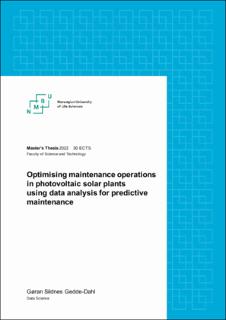| dc.contributor.advisor | Schrunner, Stefan | |
| dc.contributor.author | Gedde-Dahl, Gøran Sildnes | |
| dc.coverage.spatial | Norway | en_US |
| dc.date.accessioned | 2022-10-19T11:17:32Z | |
| dc.date.available | 2022-10-19T11:17:32Z | |
| dc.date.issued | 2022 | |
| dc.identifier.uri | https://hdl.handle.net/11250/3027040 | |
| dc.description.abstract | In PV (photovoltaic) solar power plants, high reliability of critical assets must be ensured— these include inverters, which combine the power from multiple solar cell modules. While avoiding unexpected failures and downtime, maintenance schedules aim to take advantage of the full equipment lifetime. Predictive maintenance schedules trigger maintenance actions by modelling the current equipment condition and the time until a particular failure type occurs, known as residual useful lifetime (RUL). However, predicting the RUL of an equipment is complex in this case since the equipment condition is not directly measurable; it is affected by numerous error types with corresponding influencing factors. This work compares statistical and machine learning models using sensor and weather data for the purpose of optimising maintenance decisions. Our methods allow the user to perform maintenance before failure occurs and hence, contribute to maximising reliability.
We present two distinct data handling and analysis pipelines for predictive maintenance: The first method is based on a Hidden Markov Model, which estimates the degree of degradation on a discrete scale of latent states. The multivariate input time series is transformed using PCA to reduce dimensionality. This approach delivers a profound statistical model providing insight into the temporal dynamics of the degradation process. The second method pursues a machine learning approach by using a Random Forest Regression algorithm, on top of a feature selection step from time series data. Both methods are assessed by their abilities to predict the RUL from a random point in time prior to failure. The machine learning approach is able to exploit its favourable properties in high-dimensional input data and delivers high predictive performance. Further, we discuss qualitative aspects, such as the interpretability of model parameters and results. Both approaches are benchmarked and compared to one another. We conclude that both approaches have practical merits and may contribute to more favourable decisions and optimised maintenance operations. | en_US |
| dc.language.iso | eng | en_US |
| dc.publisher | Norwegian University of Life Sciences, Ås | en_US |
| dc.rights | Attribution-NonCommercial-NoDerivatives 4.0 Internasjonal | * |
| dc.rights | Attribution-NonCommercial-NoDerivatives 4.0 Internasjonal | * |
| dc.rights.uri | http://creativecommons.org/licenses/by-nc-nd/4.0/deed.no | * |
| dc.subject | Data Science | en_US |
| dc.subject | Predictive Maintenance | en_US |
| dc.subject | TSFRESH | en_US |
| dc.subject | Hidden Markov Model | en_US |
| dc.subject | Principal Component Analysis | en_US |
| dc.subject | Random Forest Regressor | en_US |
| dc.subject | Maintenance | en_US |
| dc.subject | Solar Power | en_US |
| dc.subject | PV | en_US |
| dc.title | Optimising maintenance operations in photovoltaic solar plants using data analysis for predictive maintenance | en_US |
| dc.type | Master thesis | en_US |
| dc.description.version | submittedVersion | en_US |
| dc.description.localcode | M-DV | en_US |

